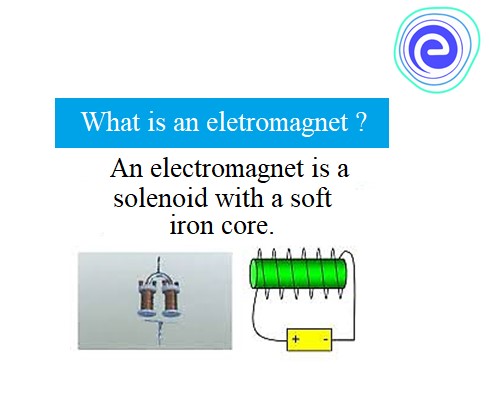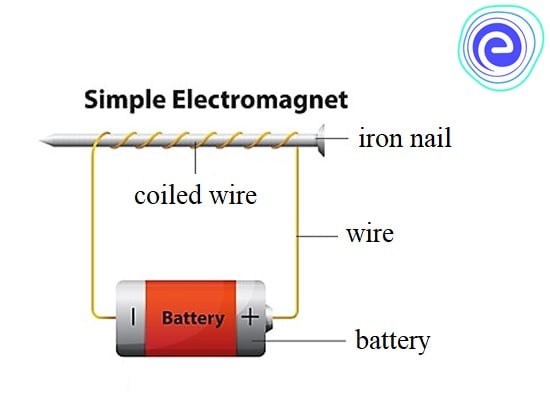General terms related to spherical mirrors: A mirror with the shape of a portion cut out of a spherical surface or substance is known as a...

General Terms Related to Spherical Mirrors
April 11, 2024
A magnet that is powered by electricity is known as an electromagnet. The electromagnetic strength can be adjusted by modifying the electric current flowing through it. The property of magnetism is lost when the current flow is interrupted.
An electromagnet is a device that consists of a magnetic core encircled by a coil through which an electric current is carried to magnetise the core. Magnets attract other magnets and magnetic materials towards them.
The relation between electricity and magnetism was a subject of study for various scientists like Micheal Faraday and Hans Oersted. James Maxwell, in 1873, observed that when current is passed through a wire, a magnetic field is generated around the wire. This became the basis for the development of Electromagnets.
The word “Electromagnet” is a combination of two words: “Electric” and “Magnet”. Thus, an electromagnet is defined as a magnet created by the flow of electricity. The electromagnet can be switched on and off easily, and its strength can be varied according to our needs.
A simple electromagnet can be made by wrapping a coil of insulated copper wire on an iron core. As the current flows through the wire, we know that a magnetic field is generated around it, thereby creating an electromagnet.

The insulated copper wire, being a great conductor of electricity, maximises the current flow and the insulation helps us touch the wire, which would otherwise be very hot. We use iron core because iron is a ferromagnetic material. It is highly absorbent, i.e. it can support a strong magnetic field around it. The magnetic field generated across an electromagnet depends on the current flowing through it.

The direction of the magnetic field can be determined by using the right-hand rule or right-hand thumb rule. According to this rule, if the fingers of our right hand curl in the direction of the current flow, the thumb will point in the magnetic field direction.
The flow of electric current through a conductor forms an electromagnet. As electrons move across a conductor, a magnetic field is generated, which powers the electromagnet. A wire wound in the form of a coil acts as an electromagnet when current flows through it. The power source supplying current can be a battery. This magnetic field is concentrated around the hole present at the centre of the coil. This field disappears as soon as the current is switched off.

The strength of this electromagnet can be enhanced by adding a magnetic core in the centre of the coil. The coil is usually made from a ferromagnetic material. The ferromagnetic core (like an iron nail) strengthens the magnetic field in the coil, thereby making the electromagnet powerful and sturdier. A wire wound in a cylinder carrying an electric current is called a solenoid.
Forces of attraction and repulsion exist between charges like electrons and protons when these are at rest. As these charges start moving, magnetic forces are produced around these charges, creating an electromagnetic field. Just as a magnet comprises of all smaller constituents, all matter, even an electromagnet consists of atoms. In general, when no electric current is being supplied across the solenoid, the atoms within its metal core are present in random order and not aligned along a particular direction.

As electricity is supplied to the solenoid, the magnetic field penetrates its magnetic core and aligns its atoms in a particular direction. As these atoms get aligned in the same direction, the magnetic field around the solenoid gets stronger. Magnetic domains (small regions of aligned atoms formed throughout the metal core) increase and decrease with the amount of current. Thus, by controlling the electricity flowing through a solenoid, we can control the strength of the resulting electromagnet. Although, when all these magnetic domains are perfectly aligned, there will not be any increase in the magnetism of the electromagnet by supplying more electric current, at this point, the magnetic field around it is said to be saturated.
When the current is switched off, the atoms lose their alignment and return to their natural (random) state and the magnet losses its magnetism. Thus, we can effectively turn on and off the magnet by controlling the current flowing through it.
The most significant advantage of the electromagnet is that just by reversing the direction of the current, they can be polarised, which is why they are used for building electric generators or motors. The main benefit of using an electromagnet over a permanent magnet is that its magnetic field strength can be supervised by controlling the current flowing through the winding. However, a permanent magnet does not need any power, but an electromagnet requires a constant electric current to provide the magnetic field.
An electromagnet functions because the current flowing through a coil generates a magnetic field. Any source of electric current can be used to power an electromagnet. Such a source can either be small batteries at home or fuel-based power stations that supply electricity directly into the grid. Consider the example of a household battery. Each battery has two significant terminals, positive and negative, to derive the electric energy. The electrons are collected at the negative terminal when the battery is not used. When we insert a battery into a device, its terminals come in contact with the metal contacts of the device. This completes the circuit, and the electrons start flowing between the battery’s terminals. As the electrons start flowing, a magnetic field is created around the device, behaving like a small electromagnet. In fact, the device would attract small magnetic objects like paper clips even after the battery is removed from it.
In large particle accelerators, strong electromagnets are powered directly by power plants. These supply a large amount of current into the particle accelerators to energise the electromagnets.

Using an electromagnet provides us with flexibility in the strength of the magnetic field. But for a given electromagnet, its magnetic field can be increased by:
An electromagnet is a magnet in which a magnetic field is generated by passing the current through the coil. We need to wound the coil around a ferromagnetic core to create a strong electromagnet. The earth’s core consists of molten iron, and the earth has its magnetic north and south pole. Unlike the geographic North and South poles, these magnetic poles are not mere locations on the earth; these are real poles with opposite polarities.
Massive electric currents are created in this iron core due to the movement of liquid iron across the outer core; this phenomenon is known as the Dynamo effect. Due to this effect, current starts flowing in the core and a magnetic field is generated. This magnetic field is the reason behind the natural magnetism of the earth. Thus, the earth behaves like an electromagnet. A compass needle always aligns itself in the north-south direction in response to the earth’s magnetic field.
An electromagnet is defined as a magnet created by the flow of electricity. A simple electromagnet is made by wrapping a coil of wire on an iron core. As the current flows through the wire, we know that a magnetic field is generated around it, thereby creating an electromagnet. As electricity is supplied to the solenoid, the magnetic field penetrates its magnetic core and aligns its atoms along a particular direction. As these atoms get aligned in the same direction, the magnetic field around the solenoid gets stronger.
Magnetic domains (small regions of aligned atoms formed throughout the metal core) increase and decrease with the current. Thus, by controlling the electricity flowing through a solenoid, we can control the strength of the resulting electromagnet. The strength of an electromagnet can be increased by increasing the number of turns of the coil, increasing current through the coil, and using a ferromagnetic core.
Q.1. What is an electromagnet?
Ans: The type of magnet in which the flow of current produces a magnetic field around the wire wound up in the form of a coil is called an electromagnet.
Q.2. How can we make an electromagnet?
Ans: We can create a simple electromagnet using a coil of wire wrapped around an iron core. A core of ferromagnetic material like iron increases the strength of the magnetic field. The amount of magnetic field generated is proportional to the current flowing through the winding.
Q.3. Write a few uses of electromagnets.
Ans: a. Motors and generators
b. Transformers and Relays
c. Electric bells and headphones
d. MRI machines and Scientific equipment such as mass spectrometers
e. Industrial lifting magnets
Q.4. Why are electromagnets preferred over permanent magnets?
Ans: The electromagnets can be switched off and on as per requirement. The strength of the magnetic field generated across an electromagnet can be controlled by the current flowing through it. In a permanent magnet, the magnetic field can not be altered, and its magnetic field can not be switched off.
Q.5. How can we increase the strength of an electromagnet?
Ans: We can increase the strength of an electromagnet by:
1. Increasing the number of windings in the coil
2. Increasing the amount of current flowing through the coil
3. By winding the coil around a ferromagnetic core.
We hope this detailed article on Electromagnet helps you in your preparation. If you get stuck do let us know in the comments section below and we will get back to you at the earliest.